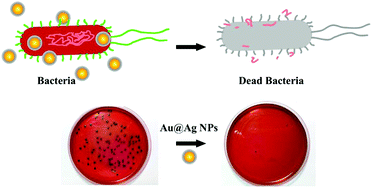Shell thickness-dependent antibacterial activity and biocompatibility of gold@silver core–shell nanoparticles†
Abstract
Antimicrobial activity of silver is highly effective and broad-spectrum; however, poor long-term antibacterial efficiency and cytotoxicity toward mammalian cells have restricted their applications. Here, we fabricated Au@Ag NPs with tailored shell thickness, and investigated their antibacterial activities against both Gram-negative bacteria (Escherichia coli) and Gram-positive bacteria (Staphylococcus aureus) and the cytotoxicity toward SH-SY5Y human cells, for the first time. Our results demonstrate that Au@Ag NPs with a thickness of 5 nm or Au : Ag ratio 1 : 1 (Au@Ag-2 NPs) have the highest antibacterial activity and excellent biocompatibility. The minimum inhibitory concentration (MIC) values of Au@Ag-2 NPs in terms of effective silver concentration are 5 µg mL−1 for E. coli and 7.5 µg mL−1 for S. aureus, which is significant lower than that of Ag NPs or the simple mixture of Ag and Au NPs and suggests the synergistic effects of Au and Ag in core–shell NPs. Live/dead bacterial assay and scanning electron microscope (SEM) images demonstrated that the Au@Ag NPs disrupt the bacterial cell membrane which subsequently results in cellular material leakage and cell death. The Au@Ag NPs may have great potential as effective antibacterial agents for pathogen control in hospitals and food processing.



 Please wait while we load your content...
Please wait while we load your content...